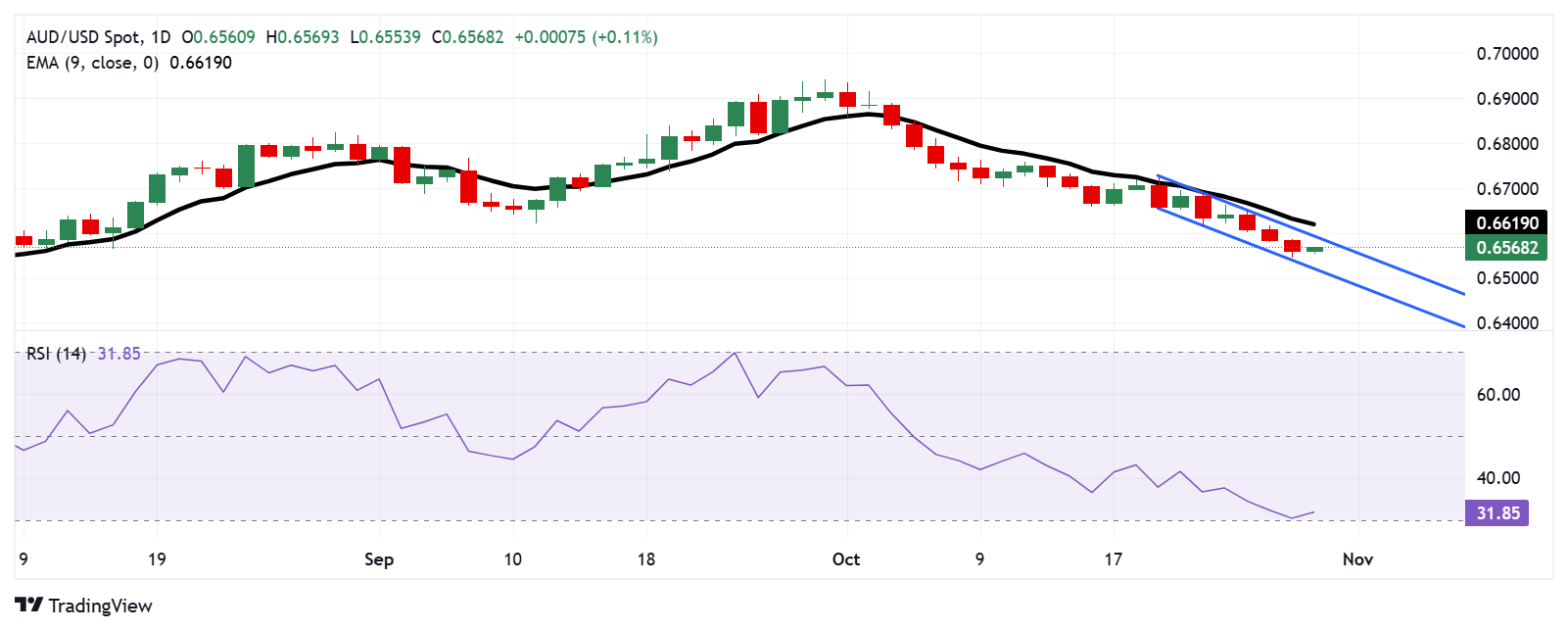- The Australian Dollar remains elevated following the release of lower-than-expected CPI data on Wednesday.
- Australia’s monthly CPI rose 2.1% year-on-year in September, coming in below the expected 2.3% and the previous reading of 2.7%.
- The US dollar could appreciate due to persistent market caution amid uncertainty surrounding the US presidential election and US data.
The Australian Dollar (AUD) rises against the US Dollar (USD) despite Australia’s third quarter Consumer Price Index (CPI) data released on Wednesday coming in lower than expected. The AUD’s rise could be attributed to the hawkish sentiment around the Reserve Bank of Australia (RBA) regarding its policy outlook.
The Australian Bureau of Statistics reported that the Consumer Price Index (CPI) rose just 0.2% quarter-on-quarter in the third quarter, up from 1.0% in the previous quarter and slightly below the 0.3% anticipated. The monthly CPI rose 2.1% year-on-year in September, falling short of market expectations of 2.3% and down from August’s reading of 2.7%.
The US Dollar saw a slight downward correction while US Treasury yields moved lower. However, the USD’s decline could be limited, with market caution persisting due to uncertainty surrounding the upcoming US presidential election and anticipation of the release of key US economic data.
Traders will likely watch the upcoming release of preliminary US third-quarter Gross Domestic Product (GDP) figures and the October Non-Farm Payrolls (NFP) report, as these could offer important insights into the timing and the pace of rate cuts expected by the Federal Reserve (Fed).
Daily Market Summary: Australian Dollar Rises on RBA’s Dovish Stance
- Last week’s positive US economic data indicates continued resilience in the economy. This supports sentiment for nominal interest rate cuts by the Federal Reserve (Fed) in November. According to the CME FedWatch tool, there is a 98.4% chance of a 25 basis point rate cut by the Fed in November, with no expectation of a more substantial 50 basis point cut.
- Australia’s CPI fell to 2.8% year-on-year from 3.8% previously, marking the lowest level since the first quarter of 2021 and falling short of market forecasts of 2.9%.
- The U.S. Bureau of Labor Statistics (BLS) reported Tuesday that JOLTS job postings reached 7.443 million in September, up from 7.861 million in August and below the market expectation of 7.99 million. .
- The Reserve Bank of Australia said the current cash rate of 4.35% is sufficiently restrictive to guide inflation back to the 2%-3% target range while continuing to support employment. As a result, a rate cut in November appears unlikely.
- ANZ-Roy Morgan Australia consumer confidence fell to 86.4 this week, from 87.5 the previous week.
- Last week, Federal Reserve Bank of San Francisco President Mary Daly stated in a post on social media platform returning to a more sustainable path.
- RBA Deputy Governor Andrew Hauser highlighted the country’s high labor participation rate last week and stressed that while the RBA is data-driven, it is not overly data-focused.
Technical Analysis: Australian Dollar remains above 0.6550 within the descending channel
AUD/USD is trading near 0.6560 on Wednesday, with daily chart analysis indicating a short-term bearish bias as the pair remains within a descending channel. However, the 14-day Relative Strength Index (RSI) stands at 30, signaling an oversold condition that could lead to an upward correction.
On the support side, the AUD/USD pair could test the lower boundary of the descending channel around 0.6520, followed by the psychological level of 0.6500.
As for resistance, the first hurdle lies at the upper boundary of the descending channel near 0.6590, with a psychological level of 0.6600 above that. A break above the latter could pave the way for the AUD/USD pair to reach the nine-day exponential moving average (EMA) at 0.6619.
AUD/USD: Daily Chart
Australian Dollar PRICE Today
The table below shows the percentage change of the Australian Dollar (AUD) against major currencies today. Australian dollar was the strongest currency against the US dollar.
| USD | EUR | GBP | JPY | CAD | AUD | NZD | CHF | |
|---|---|---|---|---|---|---|---|---|
| USD | -0.07% | -0.04% | -0.15% | -0.04% | -0.13% | -0.05% | -0.05% | |
| EUR | 0.07% | 0.03% | -0.08% | 0.03% | -0.06% | 0.02% | 0.02% | |
| GBP | 0.04% | -0.03% | -0.12% | -0.01% | -0.10% | -0.02% | 0.00% | |
| JPY | 0.15% | 0.08% | 0.12% | 0.11% | 0.03% | 0.10% | 0.12% | |
| CAD | 0.04% | -0.03% | 0.00% | -0.11% | -0.10% | -0.01% | 0.00% | |
| AUD | 0.13% | 0.06% | 0.10% | -0.03% | 0.10% | 0.09% | 0.09% | |
| NZD | 0.05% | -0.02% | 0.02% | -0.10% | 0.01% | -0.09% | 0.01% | |
| CHF | 0.05% | -0.02% | 0.00% | -0.12% | -0.01% | -0.09% | -0.01% |
The heat map shows percentage changes for major currencies. The base currency is selected from the left column, while the quote currency is selected from the top row. For example, if you choose the Australian Dollar from the left column and move along the horizontal line to the US Dollar, the percentage change shown in the box will represent the AUD (base)/USD (quote).
economic indicator
Consumer Price Index (MoM)
The Consumer Price Index published by the Reserve Bank of Australia (RBA) and republished by Australian Bureau of Statistics It is a measure of price developments by comparing the retail prices of a representative shopping basket of goods and services. The purchasing power of the AUD is dragged down by inflation. The CPI is a key indicator for measuring inflation and changes in purchasing trends. A high reading is considered positive (or bullish) for the AUD, while a low reading is considered negative (or bearish).
Last post:
Wed Oct 30, 2024 00:30
Frequency:
Monthly
Current:
2.1%
Dear:
23%
Previous:
2.7%
Fountain:
Australian Bureau of Statistics
Source: Fx Street
I am Joshua Winder, a senior-level journalist and editor at World Stock Market. I specialize in covering news related to the stock market and economic trends. With more than 8 years of experience in this field, I have become an expert in financial reporting.








